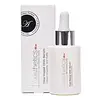What's inside
What's inside
 Key Ingredients
Key Ingredients

 Benefits
Benefits

 Concerns
Concerns

 Ingredients Side-by-side
Ingredients Side-by-side

Water
Skin ConditioningShea Butter Ethyl Esters
EmollientBrassica Glycerides
EmollientPropanediol
SolventButylene Glycol
HumectantGlyceryl Stearate Se
EmulsifyingBehenyl Alcohol
EmollientPhenoxyethanol
PreservativeGlycerin
HumectantPullulan
Hydrolyzed Hyaluronic Acid
HumectantButyrospermum Parkii Butter
Skin ConditioningSodium Hyaluronate
HumectantLecithin
EmollientSodium Acrylates Copolymer
Nannochloropsis Oculata Extract
HumectantHippophae Rhamnoides Fruit Oil
Skin ProtectingDisodium EDTA
Sodium Hydroxymethylglycinate
PreservativeRetinal
Skin ConditioningEthylhexylglycerin
Skin ConditioningLysolecithin
EmulsifyingSclerotium Gum
Emulsion StabilisingTocopherol
AntioxidantDimethylmethoxy Chromanol
AntioxidantXanthan Gum
EmulsifyingAcetyl Glutamine
Skin ConditioningGlycine Soja Oil
EmollientPotassium Sorbate
PreservativeSodium Benzoate
MaskingBacillus/Folic Acid Ferment Filtrate Extract
AntioxidantCaprylyl Glycol
Emollient1,2-Hexanediol
Skin ConditioningAcetyl Hexapeptide-51 Amide
Skin ConditioningSh-Oligopeptide-1
Skin ConditioningSh-Oligopeptide-2
Skin ConditioningSh-Polypeptide-1
Skin ConditioningSh-Polypeptide-9
Skin ConditioningSh-Polypeptide-11
Citric Acid
BufferingWater, Shea Butter Ethyl Esters, Brassica Glycerides, Propanediol, Butylene Glycol, Glyceryl Stearate Se, Behenyl Alcohol, Phenoxyethanol, Glycerin, Pullulan, Hydrolyzed Hyaluronic Acid, Butyrospermum Parkii Butter, Sodium Hyaluronate, Lecithin, Sodium Acrylates Copolymer, Nannochloropsis Oculata Extract, Hippophae Rhamnoides Fruit Oil, Disodium EDTA, Sodium Hydroxymethylglycinate, Retinal, Ethylhexylglycerin, Lysolecithin, Sclerotium Gum, Tocopherol, Dimethylmethoxy Chromanol, Xanthan Gum, Acetyl Glutamine, Glycine Soja Oil, Potassium Sorbate, Sodium Benzoate, Bacillus/Folic Acid Ferment Filtrate Extract, Caprylyl Glycol, 1,2-Hexanediol, Acetyl Hexapeptide-51 Amide, Sh-Oligopeptide-1, Sh-Oligopeptide-2, Sh-Polypeptide-1, Sh-Polypeptide-9, Sh-Polypeptide-11, Citric Acid
Water
Skin ConditioningSodium Bicarbonate
AbrasiveKetoglutaric Acid
Ascorbic Acid
AntioxidantGlycine
BufferingPropanediol
SolventProline
Skin ConditioningLysine Hcl
Skin ConditioningAloe Barbadensis Leaf Juice
Skin ConditioningAlanine
MaskingZinc Gluconate
Skin ConditioningDimethicone
EmollientAlcohol Denat.
AntimicrobialCitrus Grandis Peel Oil
MaskingUncaria Tomentosa Extract
Skin ConditioningCopper Gluconate
Skin ConditioningAcetyl Cysteine
AntioxidantPhospholipids
Skin ConditioningTocopheryl Acetate
AntioxidantAloe Barbadensis Leaf Juice Powder
Skin ConditioningLonicera Caprifolium Flower Extract
PerfumingLonicera Japonica Flower Extract
Skin ConditioningHydroxypropyl Starch Phosphate
Glycerin
HumectantMagnesium Chloride
Butylene Glycol
HumectantPolyglyceryl-4 Caprate
EmulsifyingXanthan Gum
EmulsifyingBenzyl Alcohol
PerfumingPotassium Sorbate
PreservativeWater, Sodium Bicarbonate, Ketoglutaric Acid, Ascorbic Acid, Glycine, Propanediol, Proline, Lysine Hcl, Aloe Barbadensis Leaf Juice, Alanine, Zinc Gluconate, Dimethicone, Alcohol Denat., Citrus Grandis Peel Oil, Uncaria Tomentosa Extract, Copper Gluconate, Acetyl Cysteine, Phospholipids, Tocopheryl Acetate, Aloe Barbadensis Leaf Juice Powder, Lonicera Caprifolium Flower Extract, Lonicera Japonica Flower Extract, Hydroxypropyl Starch Phosphate, Glycerin, Magnesium Chloride, Butylene Glycol, Polyglyceryl-4 Caprate, Xanthan Gum, Benzyl Alcohol, Potassium Sorbate
Ingredients Explained
These ingredients are found in both products.
Ingredients higher up in an ingredient list are typically present in a larger amount.
Butylene Glycol (or BG) is used within cosmetic products for a few different reasons:
Overall, Butylene Glycol is a safe and well-rounded ingredient that works well with other ingredients.
Though this ingredient works well with most skin types, some people with sensitive skin may experience a reaction such as allergic rashes, closed comedones, or itchiness.
Learn more about Butylene GlycolGlycerin is already naturally found in your skin. It helps moisturize and protect your skin.
A study from 2016 found glycerin to be more effective as a humectant than AHAs and hyaluronic acid.
As a humectant, it helps the skin stay hydrated by pulling moisture to your skin. The low molecular weight of glycerin allows it to pull moisture into the deeper layers of your skin.
Hydrated skin improves your skin barrier; Your skin barrier helps protect against irritants and bacteria.
Glycerin has also been found to have antimicrobial and antiviral properties. Due to these properties, glycerin is often used in wound and burn treatments.
In cosmetics, glycerin is usually derived from plants such as soybean or palm. However, it can also be sourced from animals, such as tallow or animal fat.
This ingredient is organic, colorless, odorless, and non-toxic.
Glycerin is the name for this ingredient in American English. British English uses Glycerol/Glycerine.
Learn more about GlycerinPotassium Sorbate is a preservative used to prevent yeast and mold in products. It is commonly found in both cosmetic and food products.
This ingredient comes from potassium salt derived from sorbic acid. Sorbic acid is a natural antibiotic and effective against fungus.
Both potassium sorbate and sorbic acid can be found in baked goods, cheeses, dried meats, dried fruit, ice cream, pickles, wine, yogurt, and more.
You'll often find this ingredient used with other preservatives.
Learn more about Potassium SorbatePropanediol is an all-star ingredient. It softens, hydrates, and smooths the skin.
It’s often used to:
Propanediol is not likely to cause sensitivity and considered safe to use. It is derived from corn or petroleum with a clear color and no scent.
Learn more about PropanediolWater. It's the most common cosmetic ingredient of all. You'll usually see it at the top of ingredient lists, meaning that it makes up the largest part of the product.
So why is it so popular? Water most often acts as a solvent - this means that it helps dissolve other ingredients into the formulation.
You'll also recognize water as that liquid we all need to stay alive. If you see this, drink a glass of water. Stay hydrated!
Learn more about WaterXanthan gum is used as a stabilizer and thickener within cosmetic products. It helps give products a sticky, thick feeling - preventing them from being too runny.
On the technical side of things, xanthan gum is a polysaccharide - a combination consisting of multiple sugar molecules bonded together.
Xanthan gum is a pretty common and great ingredient. It is a natural, non-toxic, non-irritating ingredient that is also commonly used in food products.
Learn more about Xanthan Gum